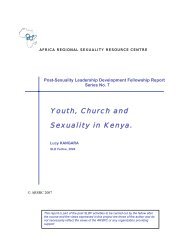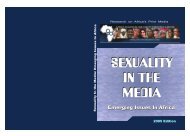body images beauty culture and language - Africa Regional ...
body images beauty culture and language - Africa Regional ...
body images beauty culture and language - Africa Regional ...
You also want an ePaper? Increase the reach of your titles
YUMPU automatically turns print PDFs into web optimized ePapers that Google loves.
Irun l’ewa obinrin (“hair is <strong>beauty</strong> of woman”)<br />
E ku ewa (”<strong>beauty</strong> greetings” - st<strong>and</strong>ard Yoruba greeting at the<br />
Gele o dun bi ka mo o we,<br />
traditional hair stylist’s. It is interesting that this<br />
acknowledgement of hair styling as a beautification<br />
process, which is obvious enough, is nonetheless<br />
specifically coded as a greeting formula in the <strong>language</strong>.)<br />
ka mo o we o dabi ko ye ni (”[having] the female headtie/headgear is one thing but<br />
knowing how to style it is another thing, while whether it<br />
fits the person wearing it is the most important<br />
consideration of all).<br />
Ìbàdí àrán (“velveteen-friendly buttocks”)<br />
Ìdi ìlẹÃkẹÃ (“beads-friendly buttocks”)<br />
Arewa (“beautiful one” – also used as name or cognomen)<br />
Egbinola (“<strong>beauty</strong> in riches/splendour” - exclusively used as name or<br />
cognomen)<br />
O dara bi egbin (“(she) is beautiful as a kob”);<br />
ỌmọÏdára (“one who is beautiful/h<strong>and</strong>some”)<br />
ỌmọÏdára ó l’ẹÏwà (“she is fine, she is beautiful”);<br />
ỌmọÏdára ó dẹjọÏ (“her <strong>beauty</strong> is problematic; it creates conflicts”);<br />
Bí ọmọ eni bá dára ka wi,<br />
ti pe a o fi se aya kọÏ (“if our daughter is a <strong>beauty</strong> we should acknowledge it<br />
[because it is true], not that we would make a wife of her”).<br />
The rationale for giving these examples is to show that there are such stock phrases<br />
regarding appearance, <strong>body</strong> parts in relation to <strong>beauty</strong>, <strong>and</strong> aspects of sexuality which<br />
have become frozen over time in traditional expression as names, cognomen, proverbs,<br />
aphorisms, sayings (as distinct from slangs) <strong>and</strong> which therefore point to primordial<br />
usage. It points to the fact that autonomous aesthetic coding of <strong>body</strong> image was part <strong>and</strong><br />
parcel of <strong>Africa</strong>n <strong>culture</strong>, while also indicating that indeed what we call ‘<strong>beauty</strong>’ has<br />
always been culturally codified.






